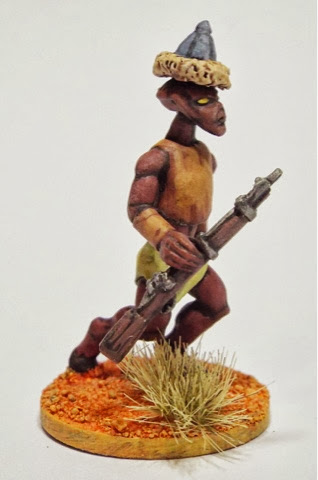As we've mentioned before, the Sky Martians tend to live in the canyons of Mars, using the winds that funnel down to get their skiffs quickly to the target.
The enclaves are generally high up on the canyon sides buried deep in the fissures of the cliff faces. Platforms allow the skiffs to load and offload Martians and their spoils, normal cargo, emissaries etc. The entrances to the enclaves are small to prevent them being over run. Some even have small mounted harpoon guns and rudimentary ballistas for defence around the platforms in case of a rival attack.
For our enclave I needed to get some height and also give an impression of a different type of rock that we have used before (cork bark) so I went with insulation or blue foam. It's light and easily carved and I had a lot lying around to use for this project.
The first picture shows the blue foam in its unpainted form. The layers were hot glued together and then I went about hacking into it with my Japanese saw (probably the best tool for this). I tried to keep the hacking at a constant couple of angles so it didn't look too chaotic.
It was then plastered in a mix of wall filler, small gravel and textured paint just pasted all over but taking care not to let it collect and disguise the texture from the saw. I then coated it in a matt brown spray making sure that there was no exposed foam and left it to dry.
The painting was quite simple, some heavy drybrushing in ever lightning shades of yellow ochre and some washes of various greens and browns to help break up the monotony. Some wind shaded areas had small amounts of sand applied and this was painted red and drybrushed the same way and then a few small plants were placed here and there to also help break it up (it is quite a large peice).
The platforms needed to have a ramshackle but sturdy appearance and so I started with the frame work, using natural clefts in the cliff face to position the skewers at various level and supporting angles. The planking was given a texture on the top and cut out by hand but keeping steady so there is an element of regularity but not that it looks factory made. The upper supports we're placed randomly but bearing in mind that they would be load bearing. Cotton thread was used to attach the upper supports and the level ones giving the appearance of stability.
The platforms were painted with a light brown (the colour for most of out Martian wood so far) then washed and drybrushed the normal way, picking out the thread in white.
The two entrances were given protective tarpaulins above them which was cloth soaked in pva to give some rigidity.
Overall a pleasing result and it will soon appear in our games as we have a small campaign in mind but more on that later.
Onto the pictures :-)




















































